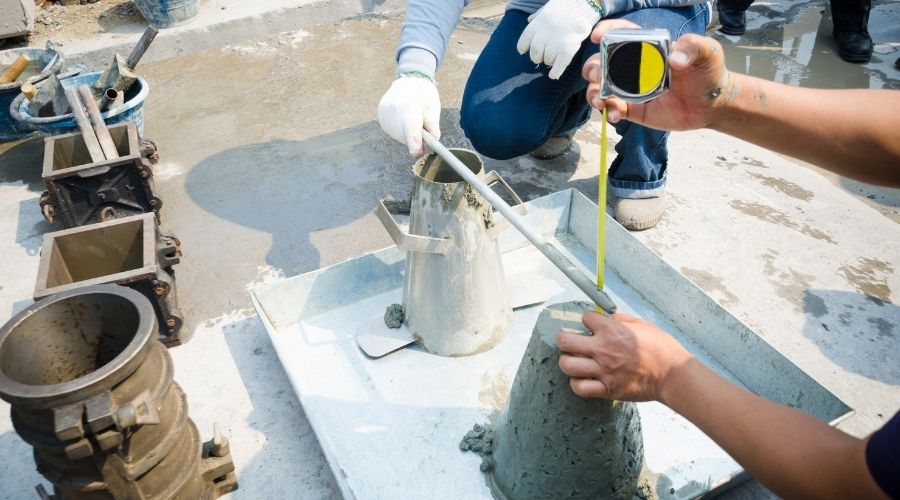
If you’re wondering, “What is the concrete slump test?” – you’ve come to the right place. At Intelligent Concrete, we help companies and contractors better work with and maintain their concrete mix design.
To help you understand this specific test, let’s define a slump test for concrete, break down why it’s used, and explain how it works.
What is a concrete slump test?
The American Concrete Institute defines slump as a measure of the consistency of freshly mixed concrete from a molded specimen after removing the slump cone. The concrete slump test determines the quality of the transported concrete to the concrete mix design. The slump test compares and measures the displaced concrete from the original height of the slump cone.
What is the concrete slump test used for?
The concrete slump exists for three primary reasons. These reasons include:
- Quality control for the concrete producer and contractor: The new properties of concrete are one of the good indicators for the quality of concrete from batching to arriving on the job site. If the concrete slump changes significantly from the design, then measures need to be taken to get it within the designed range – otherwise, the concrete mix should be rejected. If the slump loss is within the slump design range (4-6 inches, 6-8 inches, etc.), then little to no action needs to be taken in dialing in the concrete mix.
- Workability for the contractor: The concrete contractor orders the concrete slump based on the type of jobsite, how the concrete is transported from the truck to the formwork, and the experience of their crew. The slump test gives the concrete contractor a concrete test that ensures that what they ordered from the concrete producer is what they received on the concrete construction site.
- Slump loss and slump recovery: The amount by which the slump of freshly mixed concrete changes during transportation from the batch plant to the concrete job site. The slump loss is recovered to its original value by adding water or admixtures to the concrete job site.
What equipment is used during slump testing?
The slump test’s equipment and standard operating procedure are governed by ASTM C 143-20 (Standard Test Method for Slump of Hydraulic-Cement Concrete). The slump cone is the primary piece of equipment used to fabricate freshly mixed concrete samples for the slump test. As prescribed by C 143, a steel rod is used to rod the concrete, and a scoop is used to place the concrete in the slump cone. A ruler or similar device is used to measure the concrete slump.
Related Content: What is the ASTM C779 test for concrete?
What is the concrete slump test process?
- Wet down the base plate that is a non-absorbent material on an even surface.
- Secure the slump cone to the base plate
- Using a scoop, fill the slump cone in the three equal lifts by volume.
- Rod each lift 25 times with the steel tamping rod and distribute the rod evenly over the concrete sample cross-section. Do not hit the base plate with excessive force.
- Fill the slump cone slightly over the top edge for the final lift.
- Strike off the concrete from the top of the slump cone using the tamping rod or a straight edge as a screed in a rolling or sawing motion.
- Before pulling the slump cone, clean the excess concrete from the base plate or surface the cone is on.
- While holding the slump cone down, step off the slump cone tabs and slowly lift the slump cone without any lateral or torsional movement in 5 to 7 seconds.
- Invert the slump cone adjacent to the concrete sample to take a slump measurement.
- Measure from the top of the inverted slump cone to the displaced center of the top of the concrete sample.
- Measure and record the concrete slump to the nearest 0.25 inch.
Need help with concrete slump testing?
At Intelligent Concrete, we help companies and contractors all around the world work with better, safer, longer-lasting concrete, and we’d love to help you, too.
With decades of combined experience providing concrete slump tests, we can work with your team to control the quality and consistency of your concrete mix.
Give us a call or reach out to us online to learn more.
